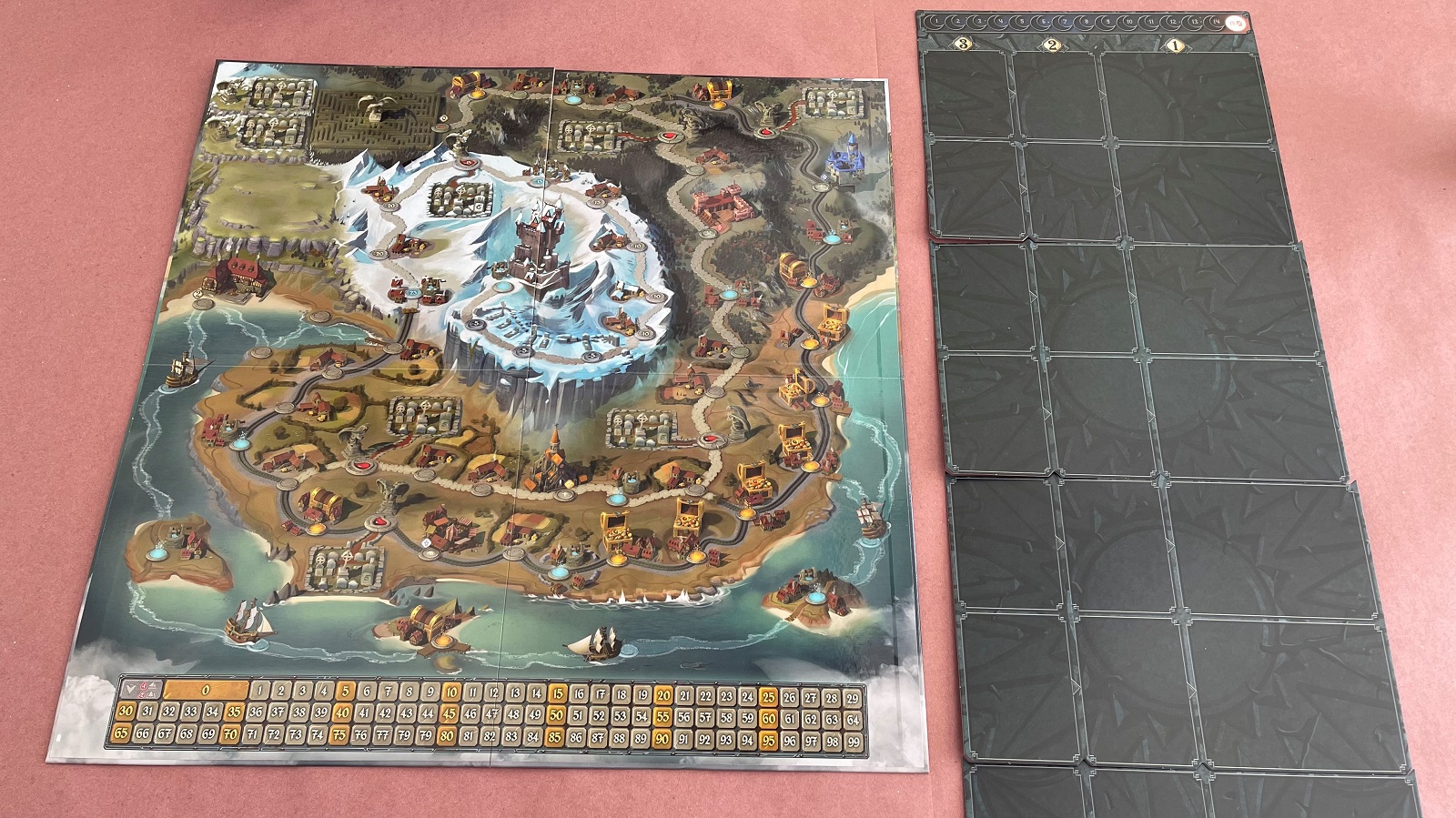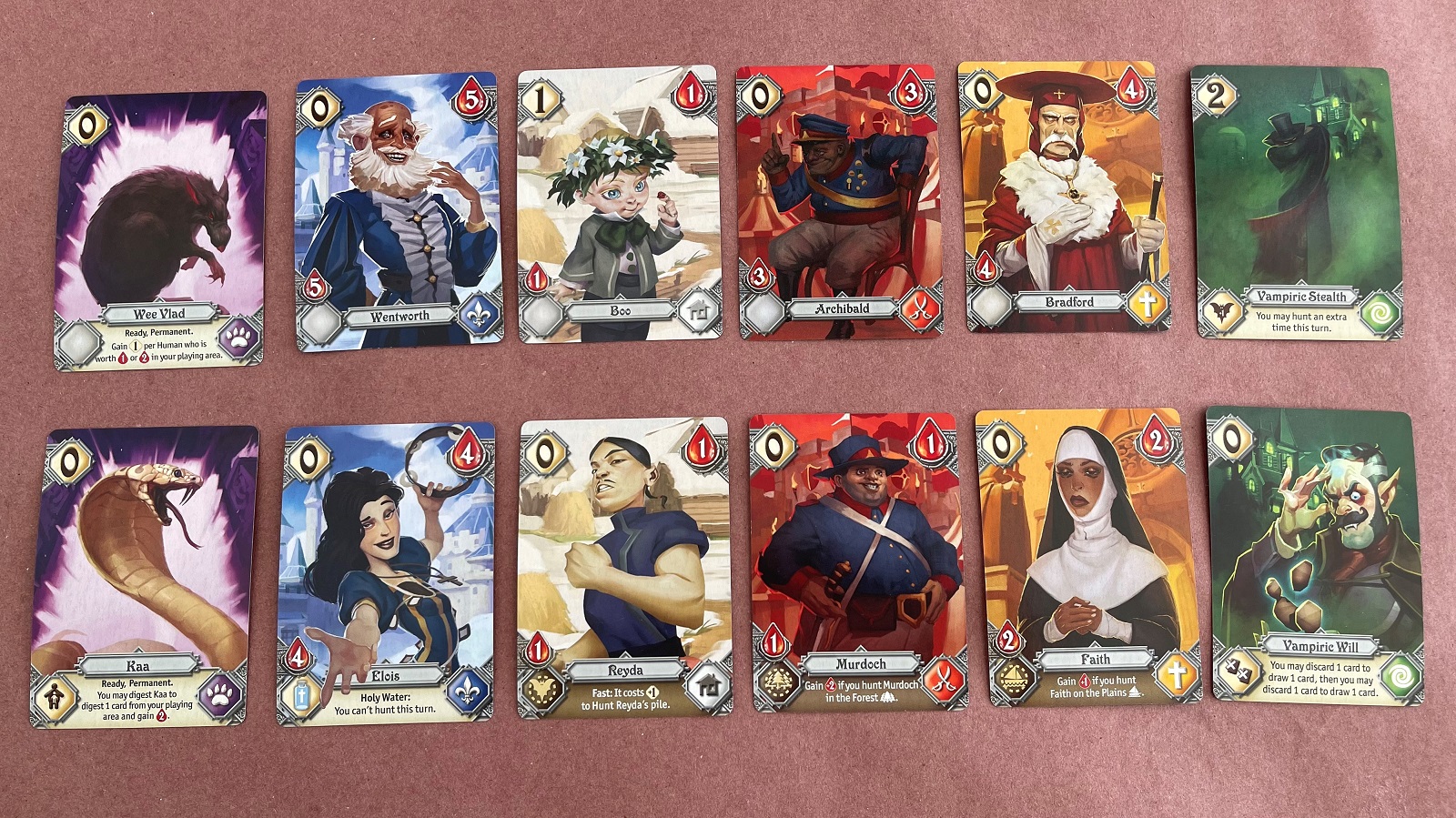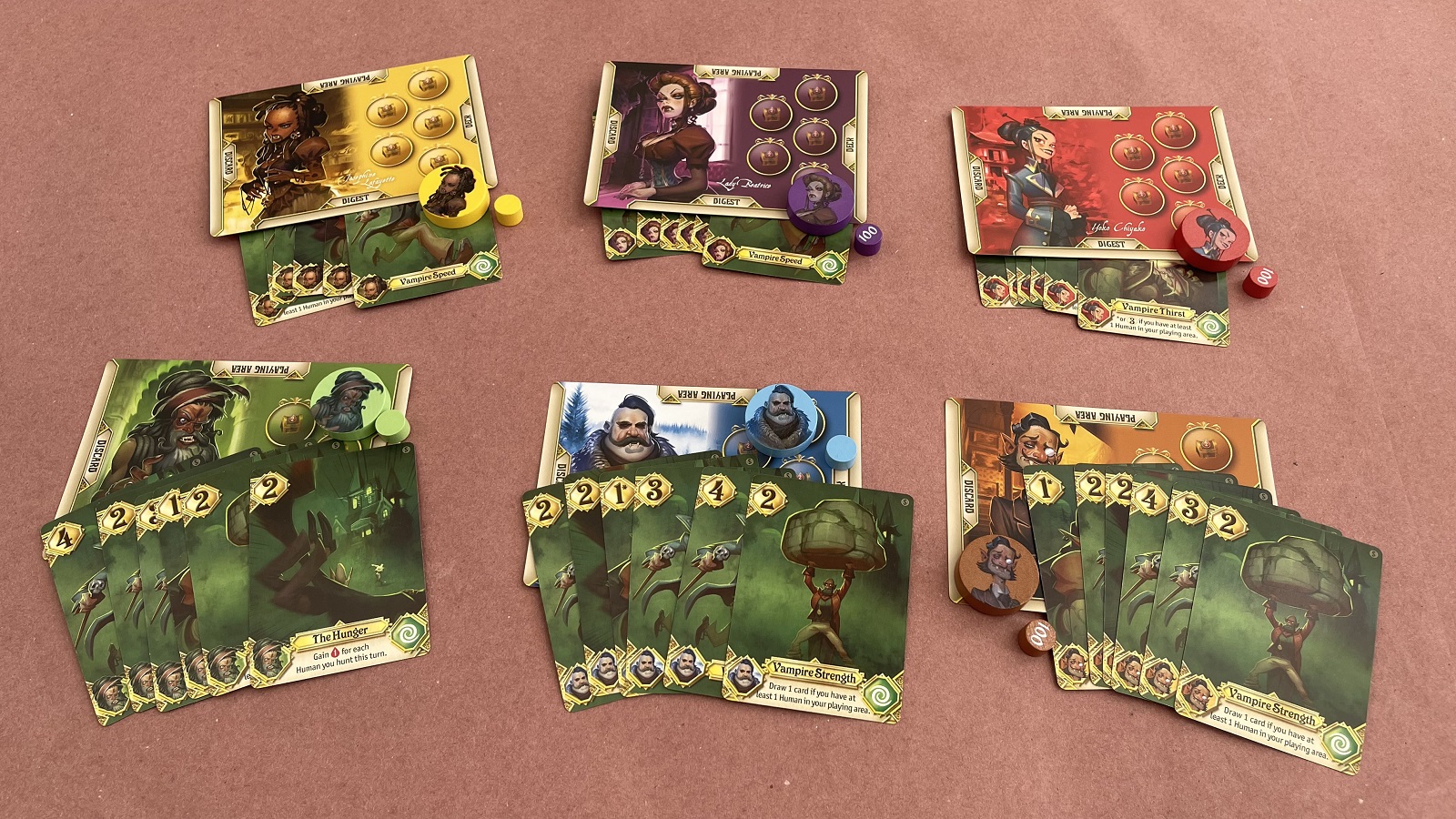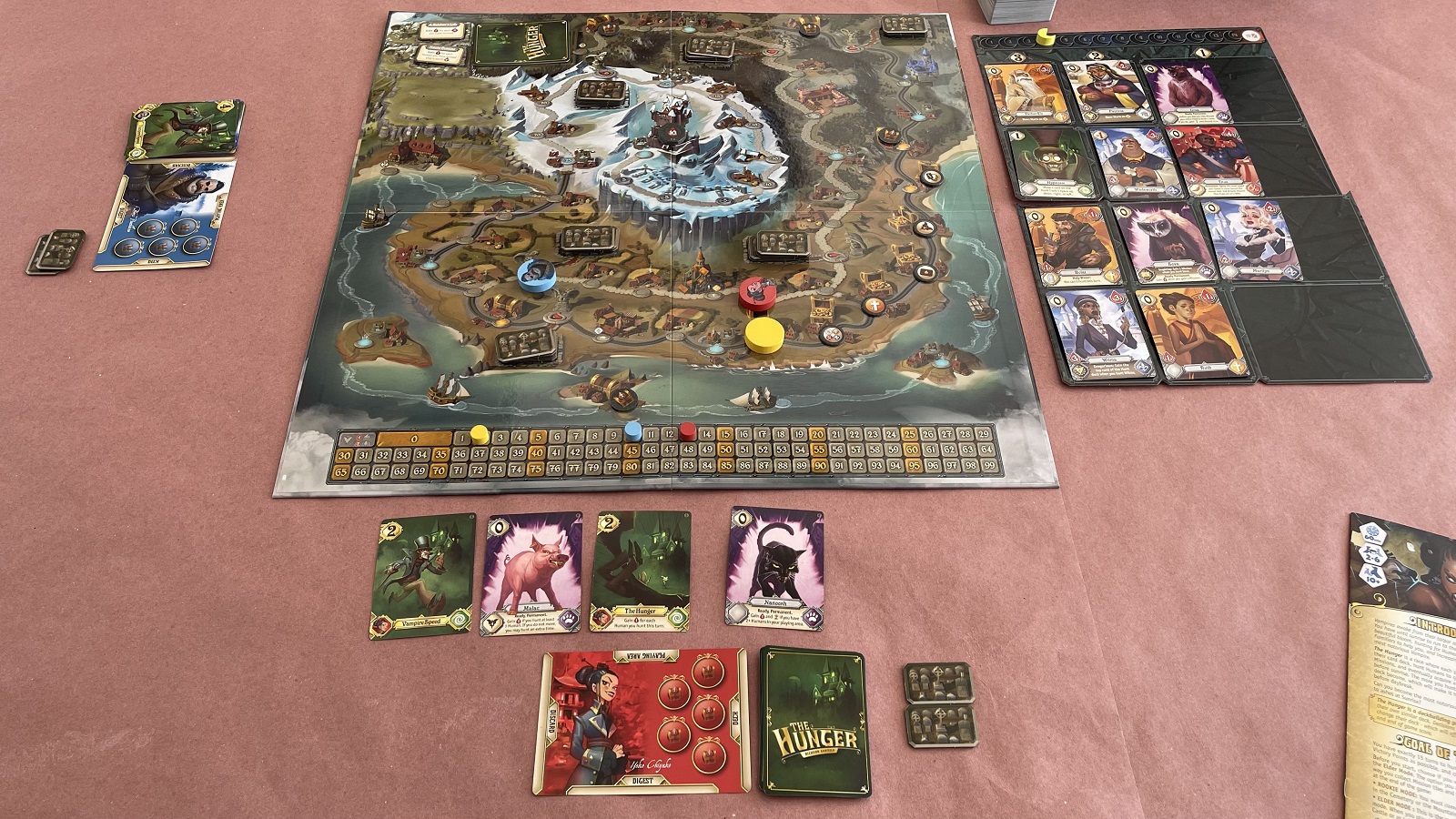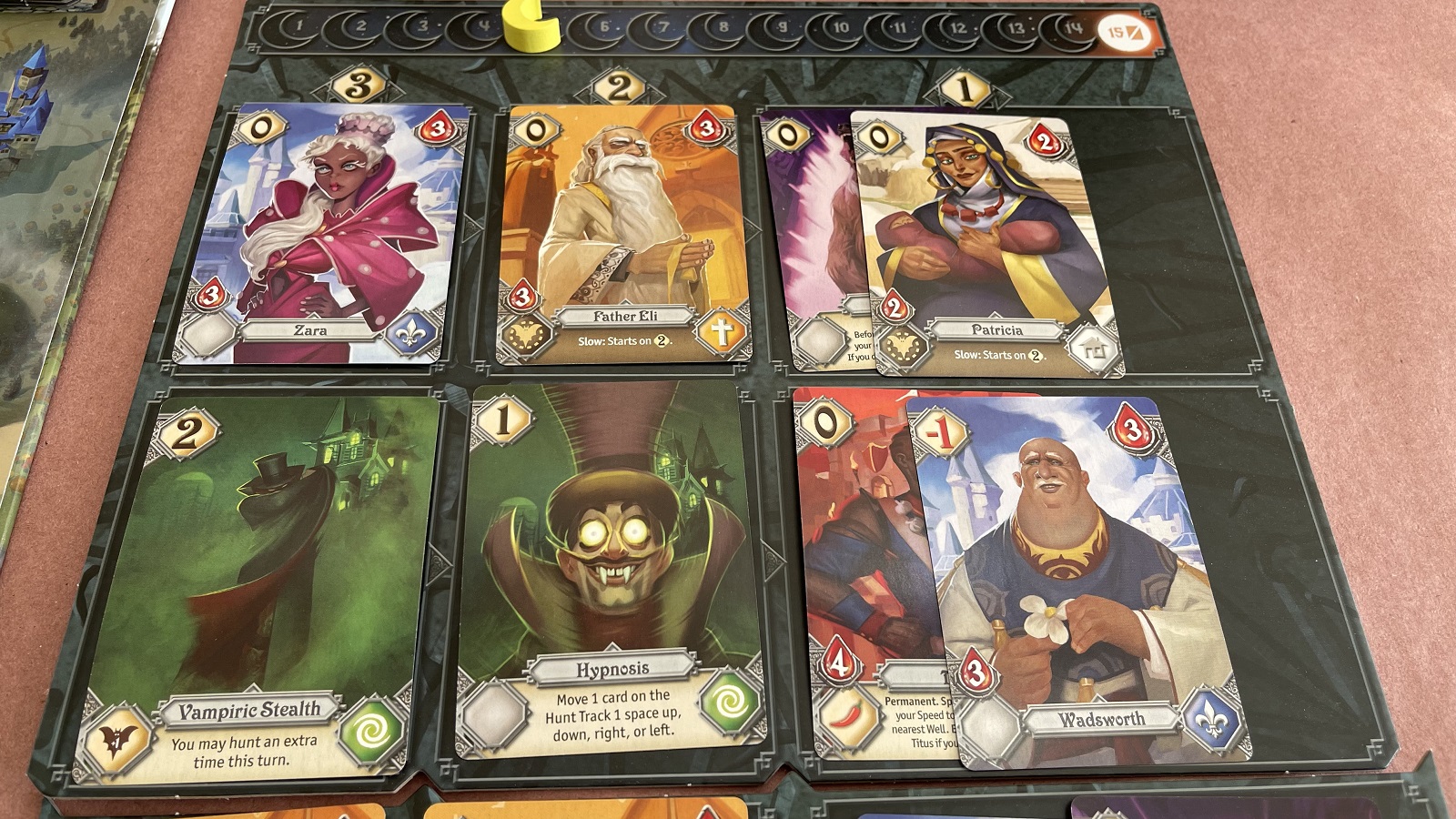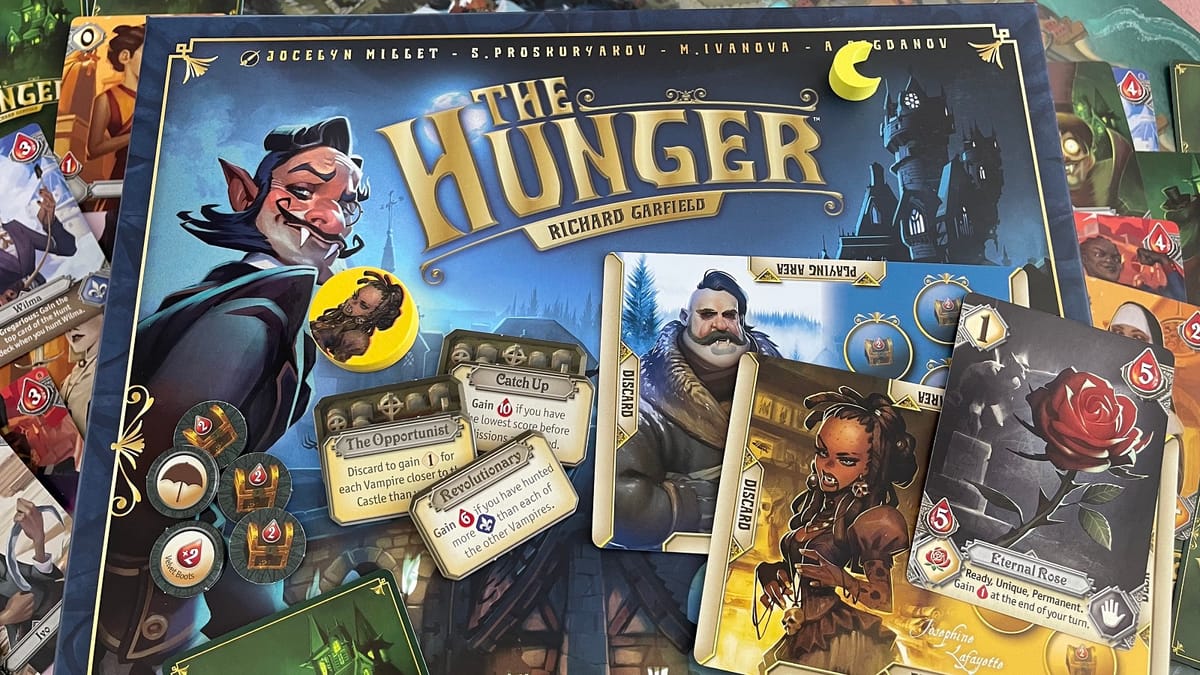
The sun has finally dropped below the horizon and the castle gates open for the local vampires to begin the nightly hunt to satiate their hunger for human blood. Sprinting into the darkness, the vampires run through the mountains, then the plains, then the forest and finally reach the labyrinth to find a single, unique rose. With rose in hand, feeding on the local populace when they can, the vampires race back to the castle to reach the safety of its walls before the sun rises in the morning. The Hunger, designed by Richard Garfield and published by Renegade Games, is a vampire-themed deck-building board game for two to six players. Players take on the roles of vampires trying to earn the most victory points (symbolized by drops of blood) by hunting humans, catching familiars, and collecting up missions all before the night ends and the sun’s burning light hits the land.
The game box is filled with a stack of cards, a handful of cardboard tokens, a pile of wooden player markers, a wooden turn tracker, a set of cardboard Hunt Track boards, and a game board. The game board is double-sided: one for regular play (Elder Mode); and one for beginner play (Rookie Mode). The two sides are identical except for some scoring markings. This seems a bit of a wasted opportunity. It would have been nice to have two different maps instead of two identical maps with different scoring. Rookie mode scoring could have been indicated with different coloring or some other marking and a different map could have provided variety. The board depicts a castle and the surrounding countryside which is divided into five regions, the top half of the board is green forest, the lower half is brown plains (which includes a coastline and some water), the center is white snowy mountains, nestled inside the mountains is a graveyard, and then the castle in the center. The regions are visually distinct, but colorblind players may find that the board blends into a large brownish area surrounding a central white area. Colors aside, the board artwork is both attractive and functional. There is a spiraling path starting at the castle and winding out and around the board to end at a labyrinth at the top. The path from the castle to the labyrinth is mostly road, but it splits in the plains into a railroad, a road, and boat. Along the path are stops that the vampires use during movement, each stop is signified by a circle and a building, cemetery, treasure chest, or ship. Many are just stops with no significance, but a number are specific types of stops that have additional benefits for the vampire that stops there. For instance, wells allow vampires extra hunts, while cemeteries give vampires the opportunity to pick up extra missions. In addition to the regions, paths, and stops, there are areas on the board to place cards and tokens that are associated with specific stops and a victory point tracker along the bottom.
The main cardboard tokens that come with the game are mission tokens and bonus tokens. The rectangular mission tokens have the image of a cemetery on the back which corresponds to locations where the mission tokens are stacked. The front of a mission token has a descriptive title for the mission and a brief description of its game effect. The round bonus tokens have the image of a treasure chest matching the locations on the board where they are placed. On the reverse side, each treasure token has an icon that has an impact on gameplay. A set of five octagonal scoring tokens go on the castle, they have victory point blood drops on them in descending value. Each player has a cardstock player card in their color with a unique name and character art on it. Players also have a wooden player token with their character’s portrait on it and a wooden score tracker. The last token is a yellow wooden crescent moon turn marker.
The primary components of the game are the Hunt Cards. Each vampire starts with a deck of six cards. The starter decks are identical except for the vampire’s image in the lower corner to identify whose deck it is. The Hunt Cards are divided into four types: powers; humans; familiars and rose cards (three unique). Each Hunt Card is beautifully illustrated with an image that is either evocative of a power or a portrait of the human or familiar. The cards also indicate how much movement the card provides when it is in your play area, how many victory points the card is worth when hunted, and additional information such as in-game effects and icons that impact end-game scoring. There are four different types of humans: villager; religious; military; and noble. Most Hunt Cards become part of the players’ decks and cycle through their hands multiple times a game, but some are labeled “Permanent” and remain in your play area until a specific condition removes them. A subset of Hunt Cards is marked for use in Rookie mode to seed the top of the deck with cards intended to make Rookie play a little easier by adding more utilitarian cards to the first few rounds of play.
The Hunt Track is a board with three columns numbered at the top 3, 2, and 1, representing the cost of cards in each column. The Hunt Track is adjustable by player count, coming in four pieces that are put together to change the number of rows, so there is always one more row than players. Hunt Cards are dealt face up into the 3 column each turn and those already in play slide to the right into the next lower numbered column. Cards are stacked in the 1 column as they slide down each turn. The cardboard for all four Hunt Track boards in our set was just slightly warped, making the board uneven and wavy. Each turn during game play Hunt Cards are dealt face up onto the 3 column and the cards on the Hunt Track slide one space to the right, stacking up on the 1 column.
The rulebook is eight pages chock full of illustrations and boxed explanation text. It’s efficient and to the point, no asides or flavor text, but it seems that the effort to save space cost some clarity in the rules. Since the text is so pithy, it’s necessary to reference the accompanying illustrations to understand some rules. There is at least one instance where the illustration confuses the rules a bit. Some other concepts are not spelled out at all in the words or the illustrations and you have to work it out yourself. An example: it’s never explicitly stated that using a draw effect means drawing a card and placing it straight into the play area. It seems trivial, but led to several conversations and hunting through the rulebook for clarity. Finally, some rules as presented are contradictory. We had questions about when you could use the “extra” hunt granted by stopping on a well: If you land on a well with zero Speed left and cannot hunt, do you still get an “extra” hunt, and is it a free hunt or do you have to have one speed available to spend? There were other questions that were not clearly addressed in the rulebook. Eventually, we muddled our way through and came up with what we think are the right answers and we figured out how to play the game, so the rulebook works, but it certainly could use some improvement.
At the start of the game, each player shuffles their starting hand and deals themselves three cards. On a player’s turn, they lay their hand on the table in their play area. Some cards have draw and discard effects on them which must be executed before movement in the order of the player’s choosing. The cards are discarded from the play area and drawn to the play area, not your hand. Once the player has completed drawing and discarding, they add up their remaining Speed on the cards in their play area and determine how they will spend their Speed. Players can use any amount of their available Speed to move in one direction along the path towards the labyrinth or the castle, no doubling back in a single move. If a player has left over Speed points after movement, they can use those extra points to hunt on the Hunt Track. Each numbered column represents the amount of Speed needed to hunt in that column – so brand-new cards laid this turn in column 3 cost three, last turn’s that are now in column 2 cost two, and the cards piling up in column 1 cost one. When you hunt a particular spot on the track, you take all the cards in that spot, so it’s possible to get three or more cards in one go by hunting on column one, since they stack up there over time.
Game play boils down to moving along the path and trying to gain victory points by hunting cards from the Hunt Track to incorporate into your deck. Familiars and powers are beneficial but rarely provide victory points. Humans on the other hand provide plenty of victory points, but they almost never have Speed points and several humans include negative effects. For instance, some humans are “spicy” and force you to move to the nearest well when they turn up in your play area. The cards you collect when you hunt go straight into your discard. When you empty your draw pile, you shuffle your discard pile and it becomes your draw pile. As you keep hunting your deck gets larger and larger, but each turn you draw just three cards, so the more cards you have in your deck without Speed points on them (humans), the less Speed you will have available. This matters because gaining victory points only pays off if you survive the rising of the sun. To survive unscathed, you must make it back to the castle by the end of turn fifteen. In Elder mode, if you aren’t in the castle in time, you must be in the cemetery where you still survive but lose some victory points. In Rookie mode, you have to be in the mountains and you’ll lose even more victory points. If you are caught in the plains or forest at the end you lose, regardless of how many victory points you have.
Scoring and game play change based on the familiar, power and human cards you hunt as well as the various mission and bonus tokens you collect. There are two missions that are public, placed face up on the board at the beginning of the game and used by all the vampires during scoring. Other mission tokens are gathered up by the vampires as they race through the countryside and used only by the vampire that collected them at the end of the game. As noted before, the more humans you consume, the more points you’ll get, but the less efficient your deck is and the slower you move. One mitigation for this is “digesting” the human prey in your deck. When the opportunity to digest comes up (there are spaces on the board, cards in the Hunt Deck, and tokens that allow for this), you move human cards from your play area or discard to the “digested” portion next to your player sheet. The cards still count for scoring, but they are no longer shuffled back into your deck, keeping things clean and speedy. For vampires that make it all the way to the labyrinth, there are three unique rose cards to take. Vampires can only have one rose in their deck, each has a unique scoring mechanism, and the vampire gets to choose the one they want. Players will have to decide if they want to race for a chance at a rose, stay near the castle, or do something in between. Hunting further from the castle provides more victory points per human hunted and opportunities to digest and gather useful tokens, but the farther you get from the castle, the harder it is to make it back in time.
The Hunger worked well with two players but it plays better with more players. While there is not a lot of player interaction, jockeying for position on the road is important – you can push another player’s marker the direction you want if you land on it. Since returning to the castle before the other players results in more points, then pushing around your opponents’ markers can mean the difference between winning and losing. It also makes placement relative to the castle important, since the furthest from the castle goes first each turn. Cards can affect player interaction as well, for instance, if you have the Capra familiar card in your play area, you gain victory points and force pushed opponents to discard a permanent each time you land on them. If you only have one opponent, these things factor in a lot less than if you have five opponents, especially in the last few turns when everyone is crowding onto the mountain road.
The roses only give a point or two a round depending on which rose you get, so they don’t seem to factor into the game enough to make them worth the sprint to the labyrinth. It seems like there ought to be more than just three roses or they should have larger impacts making getting the first pick of the roses and having one at the end a bigger deal. As it is, the points they generate can easily be made up for by hunting a few high-point humans. Everyone’s mileage may vary here and maybe we didn’t figure out their importance, but the players that went for roses seemed to struggle getting all the way to the labyrinth and back and also hunt for enough victory points.
Combining the deck building concept with board movement adds a great extra layer of strategy to the game and the theme works well with the mechanic. The only wonky thing theme-wise is the digestion mechanic. Digesting a human out of your deck implies that the other humans you have hunted have not been fed on. So, are you collecting them up and herding them back to the castle, or drinking their blood and leaving them behind? If you are herding them along, it doesn’t make sense to also be turning into mist and using vampire speed to zip from place to place. If you are drinking their blood, then haven’t you digested it? But, whether the humans in your deck are following you around on your adventure or falling prey to your bite, you still have the feel of a vampire on a nightly romp.
Playing the Hunger is nice and smooth. Turns go quickly, so players don’t spend a lot of time waiting, but you also don’t have that much strategy to ponder, so they generally aren’t rushed either. Unlike many deckbuilders, the focus here is not to build your deck into the best point generating machine. Because your deck also provides you with your movement points, you have to strike a balance between point acquisition and the ability to move around the board. The negative effects from some of the humans you nab force you to think about how to deal with them, or work them into your strategy. The score-points-or-move-fast tension gives the Hunger an extra layer that separates it from the rest of the pack. I am looking forward to seeing what expansions might do for this game.
Great
The Hunger seamlessly combines board game movement and interaction with deck building to create a unique experience. The vampire theme is fun and the idea that you only have the night to get everything done before you burn up makes the race home exciting. The push-your-luck element of lingering outside for some juicy victory points ramps up the fun in the final rounds. Being the first one into the cemetery with the threat of being pushed back a few times by stragglers coming in from behind keeps you on your toes. Building up a healthy victory point lead only to see your position evaporate as you lay down three zero Speed humans on your second to last turn is a tough lesson on deck building. Other than the roses not seeming to be all that important, I have no big complaints about game play. Like many deck builders, repeated play will hone your skills and make the game more entertaining, but puts new players at a heavy disadvantage against experienced players. Fortunately, you can combine Rookie and Elder modes to account for that, forcing experienced players to make it all the way to the graveyard, but letting novices finish in the mountains. The artwork for the game, a cartoony, whimsical style, is eye-catching and thematic. The main problems with the game come from the rulebook, game board and warped Hunt Track boards – all things that can be lived with. Overall, The Hunger is an excellent game that I am looking forward to putting on the table again soon.
Pros
- Excellent combination of deck building and board game
- Character art and illustrations are outstanding
- Variable scoring supports repeated play
Cons
- Too few and minimally impactful roses
- Rulebook needs work
- Gameboard's nearly identical sides seem like wasted opportunity

